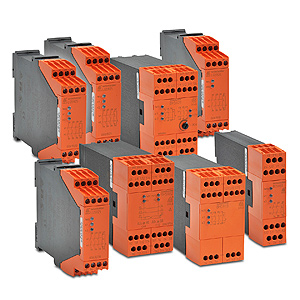Safety Relays
Safety Relays are designed to provide a convenient and economical solution for incorporating control reliability into a safety circuit. Power to the machine primary control elements is connected through the safety output contacts of the safety monitoring relay. Inputs to the monitoring relay are typically from safety devices such as emergency stop Switches, limit switches, or safety interlock switches. The safety monitoring relay’s own output safety contacts are monitored internally. If a fault occurs in the operation of one of the monitoring relay contacts, the safety relay shuts down, removes power from the machine primary control elements and prevents a start or successive cycle of the machine until the fault is cleared. In addition, the contacts of the machine primary control elements or external safety relay can be monitored by the safety monitoring relay.
The most common use of safety relays is in a hardwired configuration, with one or two safety devices feeding into the system on one zone of a machine, and around 57% of relay applications are like this. The other 43% of safety relay applications are used in more complex safety systems with three or more safety inputs and several separate safety zones. Then, as the systems become more complex, the likelihood of the user adopting a PLC-based programmable solution increases.
